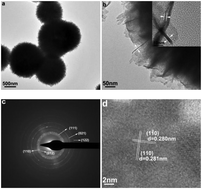Rapid adsorption and photocatalytic activity for Rhodamine B and Cr(vi) by ultrathin BiOI nanosheets with highly exposed {001} facets
Abstract
Porous BiOI microspheres composed of ultrathin nanosheets were successfully fabricated using a simple solvothermal method, and subsequently characterized by X-ray powder diffraction (XRD), scanning electron microscopy (SEM), transmission electron microscopy (TEM), ultraviolet-visible diffuse reflection spectroscopy (UV-vis), X-ray photoelectron spectroscopy (XPS) and Brunauer–Emmett–Teller surface area (BET) measurements. High-resolution transmission electron microscopy (HRTEM) results show that the typical characteristics of nanosheets were mainly within the dominant exposed {001} facets. The BiOI samples obtained exhibit rapid adsorption and photocatalytic activity for the cationic organic dye Rhodamine B (RhB) and the heavy metal ion, Cr(VI), under irradiation with visible light, which is mainly ascribed to their high degree of crystallization, highly exposed {001} facets, unique mesoporous structures, relatively large effective specific surface area (∼77.22 m2 g−1) and appropriate energy band gap (1.81 eV). Moreover, the adsorption process for RhB and Cr(VI) with the as-prepared BiOI microspheres was also analyzed by pseudo-second-order kinetic model.


 Please wait while we load your content...
Please wait while we load your content...